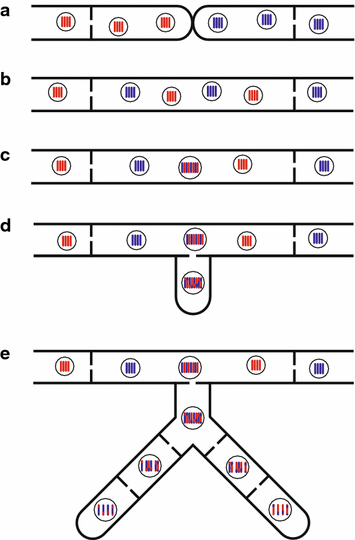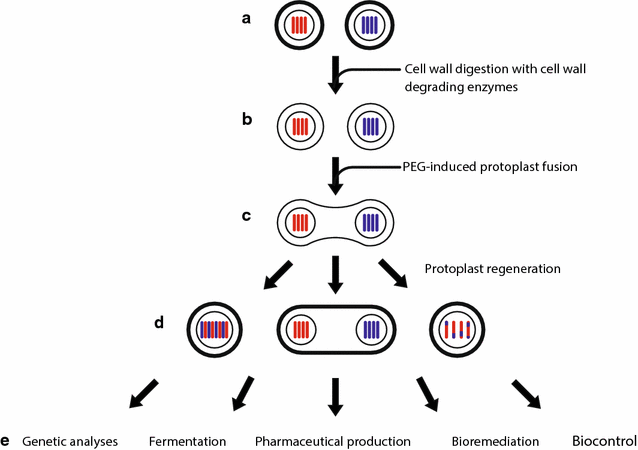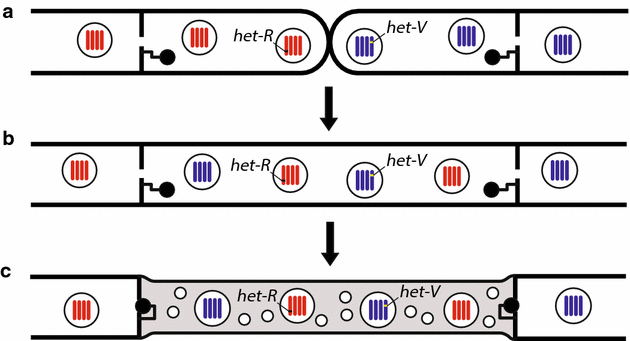Two genomes are better than one: history, genetics, and biotechnological applications of fungal heterokaryons
- PMID: 28955463
- PMCID: PMC5611628
- DOI: 10.1186/s40694-016-0022-x
Two genomes are better than one: history, genetics, and biotechnological applications of fungal heterokaryons
Abstract
Heterokaryosis is an integral part of the parasexual cycle used by predominantly asexual fungi to introduce and maintain genetic variation in populations. Research into fungal heterokaryons began in 1912 and continues to the present day. Heterokaryosis may play a role in the ability of fungi to respond to their environment, including the adaptation of arbuscular mycorrhizal fungi to different plant hosts. The parasexual cycle has enabled advances in fungal genetics, including gene mapping and tests of complementation, dominance, and vegetative compatibility in predominantly asexual fungi. Knowledge of vegetative compatibility groups has facilitated population genetic studies and enabled the design of innovative methods of biocontrol. The vegetative incompatibility response has the potential to be used as a model system to study biological aspects of some human diseases, including neurodegenerative diseases and cancer. By combining distinct traits through the formation of artificial heterokaryons, fungal strains with superior properties for antibiotic and enzyme production, fermentation, biocontrol, and bioremediation have been produced. Future biotechnological applications may include site-specific biocontrol or bioremediation and the production of novel pharmaceuticals.
Keywords: Biotechnology; Complementation; Heterokaryon; Heterosis; Parasexual cycle; Protoplast fusion; Vegetative compatibility groups.
Figures



Similar articles
-
Starvation-induced cell fusion and heterokaryosis frequently escape imperfect allorecognition systems in an asexual fungal pathogen.BMC Biol. 2021 Aug 24;19(1):169. doi: 10.1186/s12915-021-01101-5. BMC Biol. 2021. PMID: 34429100 Free PMC article.
-
Vegetative Compatibility and Heterokaryon Formation between Different Isolates of Colletotrichum Lindemuthianum by using the nit Mutant System.Braz J Microbiol. 2011 Jan;42(1):346-53. doi: 10.1590/S1517-83822011000100044. Braz J Microbiol. 2011. PMID: 24031641 Free PMC article.
-
Vegetative compatibility groups and parasexual segregation in Colletotrichum acutatum isolates infecting different hosts.Phytopathology. 2011 Aug;101(8):923-8. doi: 10.1094/PHYTO-12-10-0327. Phytopathology. 2011. PMID: 21425929
-
Molecular Mechanisms Regulating Cell Fusion and Heterokaryon Formation in Filamentous Fungi.Microbiol Spectr. 2017 Mar;5(2):10.1128/microbiolspec.funk-0015-2016. doi: 10.1128/microbiolspec.FUNK-0015-2016. Microbiol Spectr. 2017. PMID: 28256191 Free PMC article. Review.
-
The genetics of hyphal fusion and vegetative incompatibility in filamentous ascomycete fungi.Annu Rev Genet. 2000;34:165-186. doi: 10.1146/annurev.genet.34.1.165. Annu Rev Genet. 2000. PMID: 11092825 Review.
Cited by
-
Developing endophytic Penicillium oxalicum as a source of lignocellulolytic enzymes for enhanced hydrolysis of biorefinery relevant pretreated rice straw.Bioprocess Biosyst Eng. 2024 Dec;47(12):2055-2073. doi: 10.1007/s00449-024-03085-2. Epub 2024 Sep 9. Bioprocess Biosyst Eng. 2024. PMID: 39249151
-
Fungi-on-a-Chip: microfluidic platforms for single-cell studies on fungi.FEMS Microbiol Rev. 2022 Nov 2;46(6):fuac039. doi: 10.1093/femsre/fuac039. FEMS Microbiol Rev. 2022. PMID: 36001464 Free PMC article. Review.
-
Fungal evolution: cellular, genomic and metabolic complexity.Biol Rev Camb Philos Soc. 2020 Oct;95(5):1198-1232. doi: 10.1111/brv.12605. Epub 2020 Apr 17. Biol Rev Camb Philos Soc. 2020. PMID: 32301582 Free PMC article.
-
Fusarium oxysporum f. sp. lycopersici causal agent of vascular wilt disease of tomato: Biology to diversity- A review.Saudi J Biol Sci. 2019 Nov;26(7):1315-1324. doi: 10.1016/j.sjbs.2019.06.002. Epub 2019 Jun 4. Saudi J Biol Sci. 2019. PMID: 31762590 Free PMC article. Review.
-
Frequent horizontal chromosome transfer between asexual fungal insect pathogens.Proc Natl Acad Sci U S A. 2024 Mar 12;121(11):e2316284121. doi: 10.1073/pnas.2316284121. Epub 2024 Mar 5. Proc Natl Acad Sci U S A. 2024. PMID: 38442176 Free PMC article.
References
-
- Spatafora JW, Robbertse B. Phylogenetics and phylogenomics of the fungal tree of life. In: Borkovich KA, Ebbole DJ, editors. Cellular and molecular biology of filamentous fungi. Washington, DC: ASM Press; 2010. pp. 36–49.
-
- Debuchy R, Berteaux-Lecellier V, Silar P. Mating systems and sexual morphogenesis in ascomycetes. In: Borkovich KA, Ebbole DJ, editors. Cellular and molecular biology of filamentous fungi. Washington, DC: ASM Press; 2010. pp. 501–511.
-
- Weichert M, Fleißner A. Anastomosis and heterokaryon formation. In: van den Berg MA, Maruthachalam K, editors. Genetic transformation systems in fungi. Cham: Springer; 2015. pp. 3–21.
-
- Read ND, Fleißner A, Roca MG, Glass NL. Hyphal fusion. In: Borkovich KA, Ebbole DJ, editors. Cellular and molecular biology of filamentous fungi. Washington, DC: ASM Press; 2010. pp. 260–273.
Publication types
LinkOut - more resources
Full Text Sources
Other Literature Sources

